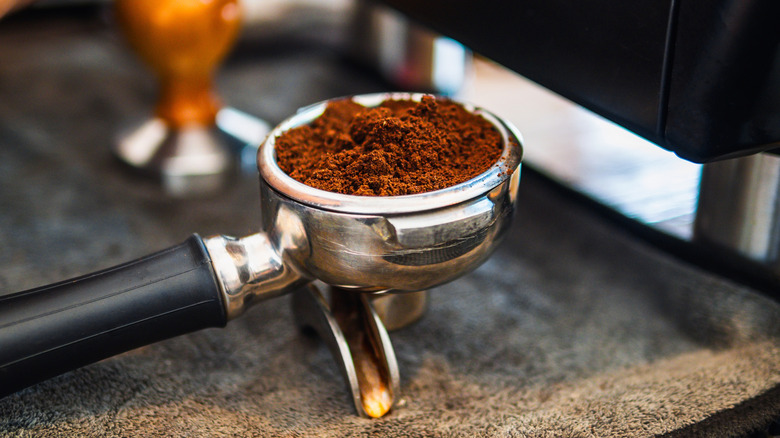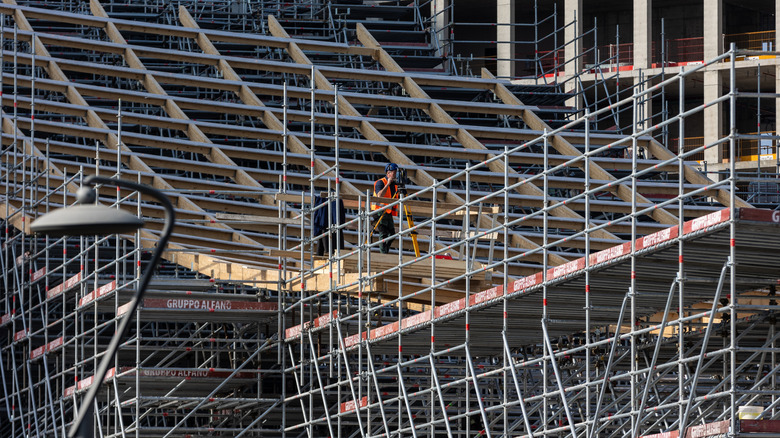Using Coffee Grounds In Concrete Has An Unexpected Effect
Coffee culture is everywhere, and the drink's impact on human productivity is undeniable. But our obsession with it comes at an environmental cost. Every year, humans produce over 7 million tons of coffee ground waste, an amount that would present a processing challenge for even the most biodegradable of waste products. To see if those grounds could be put to better use, a team of researchers at RMIT University in Melbourne developed a study that resulted in a surprising discovery: under the right conditions, spent coffee grounds can actually make concrete stronger.
In the study published in the Journal of Cleaner Production in 2023, the researchers found that when coffee grounds are converted into a substance called biochar — a material similar to charcoal produced from burning organic material — and mixed in with concrete (replacing a portion of the sand normally used), the resulting composite becomes significantly more durable than regular concrete. More than a novelty, the discovery has the potential to address two major environmental issues simultaneously: reducing organic waste and easing the demand for natural sand, which, along with other precious material deposits on the planet, is increasingly in short supply due to rapid construction and over-extraction. It could also help companies build more eco-friendly homes.
Concrete is one of the most widely used materials on the planet — and also one of the most environmentally taxing. Its production is responsible for about 8% of global carbon dioxide emissions, according to a report from Princeton University. At the same time, millions of pounds of organic food waste, including coffee grounds, generate methane as they decompose, contributing to climate change. Utilizing coffee grounds this way could help address both problems. Here's how the researchers accomplished it.
Using coffee grounds to make concrete stronger
To test the potential of coffee waste in construction, the RMIT University team didn't just toss used grounds into a concrete mix and hope for the best. Raw coffee grounds are too unstable and organic to contribute much structurally. Instead, researchers applied a process called pyrolysis — heating the spent grounds in the absence of oxygen — to transform them into biochar, a porous, carbon-rich material similar to charcoal.
The team experimented with two different pyrolysis temperatures: 662 and 932 degrees Fahrenheit. What they found was striking. The biochar that was produced at 662 degrees Fahrenheit and used to replace 15% of the sand content in a standard concrete mix resulted in a final material that was 29.3% stronger than traditional concrete. The biochar produced at 932 degrees Fahrenheit, by contrast, was less effective, demonstrating how precise temperature control is critical in achieving the material's optimal performance. Why does it work? The answer lies in the microstructure of the coffee biochar. Its high surface area and porous nature allow it to better bind with the cement paste, increasing interfacial adhesion within the concrete mix.
Although the long-term durability of the mix has yet to be tested, the team is exploring how the material performs under various stress tests that include temperature extremes and abrasions. The study results are an encouraging sign that the global construction industry could find alternatives to our current process of making concrete. "The ongoing extraction of natural sand around the world — typically taken from river beds and banks — to meet the rapidly growing demands of the construction industry has a big impact on the environment," research team leader Professor Jie Li told RMIT University. "There are critical and long-lasting challenges in maintaining a sustainable supply of sand due to the finite nature of resources and the environmental impacts of sand mining."

